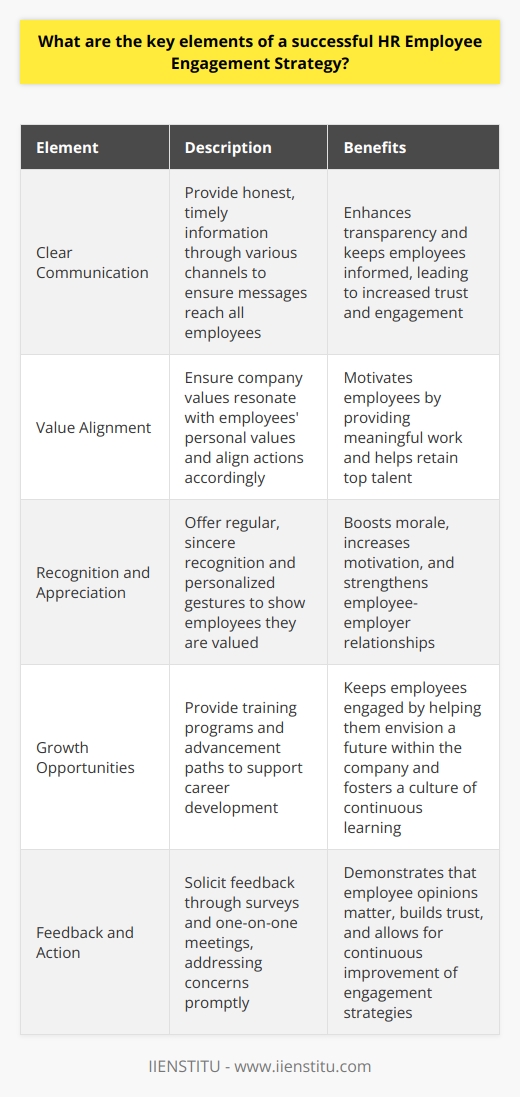In the ever-evolving landscape of the modern workplace, human resource (HR) departments play a vital role in cultivating and enhancing employee engagement—a factor that has proven critical for business success. With advancing globalization and the consequential diversification of workforces, HR Employee Engagement Strategy has become a subject deserving meticulous exploration and strategic development. This article elucidates the pivotal concepts and practices of such strategies, providing a compass to HR professionals as they navigate through the complexities of stimulating and retaining a committed workforce.
Understanding HR Role in Employee Engagement
Facilitating Employee Communication
Employee engagement begins with communication, and it is the responsibility of HR leaders to build and maintain open channels for dialogue. By fostering a culture where employees feel listened to and are encouraged to share their ideas and concerns, trust can be established and maintained, thus bolstering engagement. HR must ensure these lines of communication are not just top-down but also encourage peer-to-peer interactions which are fundamental for collaborative work environments.
Evaluating Employee Well-being
The scope of employee engagement extends beyond job satisfaction to encompass overall well-being. HR professionals must actively pursue policies that promote mental, emotional, and physical health at work. Evaluating well-being involves understanding the workplace's impact on employees and implementing programs that support a healthy work-life balance, contributing to enhanced productivity and job satisfaction.
Connection Between HR and Employee Engagement
Ultimately, the HR department acts as the catalyst of employee engagement within an organization. They are tasked with translating business goals into engagement strategies that align with employees' values and aspirations. The successful HR practitioner understands that the heart of engagement lies in genuine connections between a company’s vision and the personal growth of its employees.
Steps to Building an Effective HR Employee Engagement Strategy
Define Clear Engagement Goals
Setting Engagement Vision and Objective
The foundation of a successful employee engagement strategy is the clear definition of what engagement looks like within the organization. HR professionals must create a vision that is both inspiring and attainable, with a set of objectives that are closely aligned with the company's mission and operational realities.
Aligning Engagement Goals with Organizational Values
To ensure a sense of collective purpose, engagement goals must reflect the core values of the organization. When employees see their work contributions as part of a greater endeavor that they value personally, engagement levels can soar. This synergy between individual purpose and organizational aims can lead to a thriving workplace culture.
Encouragement for Employee Participation and Ownership
Encouraging Open Dialogues
An important step in cultivating engagement is to incentivize employee participation through active dialogues. HR can facilitate this by creating platforms where input from all levels is not only accepted but genuinely considered and acted upon, thus fostering a shared sense of ownership in company outcomes.
Cultivating Culture of Collaboration
Building a collaborative culture is about more than merely assigning group projects; it's about creating an ecosystem where teamwork and cross-functional cooperation are not just encouraged but embedded in the organizational DNA. Such a culture propels employees to feel part of a united community, thus enhancing engagement.
Measure Employee Engagement
Employee Surveys and Feedback
Proper measurement is a cornerstone of any strategy, and employee engagement is no exception. Conducting regular surveys and collecting feedback helps HR departments gauge the current state of engagement and identify areas for improvement.
Businesses Partnering With Education Companies To Reduce Workplace İlliteracy
İmpact Of Hr Morale Programs On Employee Retention And Satisfaction
Conduct Regular Performance Reviews
Performance reviews provide an opportunity for personal interaction, where employees can discuss their achievements and challenges. By engaging in goal-oriented reviews, HR can help employees align their personal career goals with the strategic direction of the organization.
Use of HR Analytics to Make Data Driven Decisions
Data analytics in HR can reveal trends and patterns about engagement levels across various departments and demographics within the organization. By leveraging this data, HR professionals can make informed decisions about where to focus their engagement efforts for maximum impact.
Examples of Successful HR Employee Engagement Strategies
Case Study of Google’s Employee Engagement Strategy
Google is often hailed as a paradigm of employee engagement, with its open culture and innovative HR practices. In-depth analysis reveals a strategy deeply intertwined with corporate values—ones that prioritize employee well-being and creativity, attributes that have contributed to the tech giant's unassailable market position.
Analysis of Southwest Airlines’ Engagement Initiatives
Southwest Airlines also provides a compelling case study in employee engagement. The company’s celebrated culture is characterized by camaraderie and a spirited sense of employee ownership, which have been key drivers of its consistent success over the years.
Common Challenges and Solutions in Implementing HR Employee Engagement Strategies
Overcoming Communication Barriers
Communication barriers, both organizational and interpersonal, can significantly impede the effectiveness of engagement strategies. HR must identify and actively work to dismantle these barriers, creating an environment where open and transparent communication is not only possible but naturally occurring.
Addressing Employee Burnout
Burnout remains a formidable obstacle in maintaining employee engagement. Proactive HR teams will establish metrics to monitor workloads, set boundaries to prevent overwork, and ensure management is attuned to the early signs of burnout among employees, taking measures to mitigate its effects.
Dealing with Resistance to Change
Resistance to change is a natural human sentiment and can be a hurdle in implementing new engagement practices. Anticipation of resistance and preparing the workforce through transparent change management processes can help HR professionals successfully integrate new engagement strategies.
The Role of Technology in Enhancing HR Employee Engagement
Utilizing HR Tech for Personalized Employee Experiences
The growing field of HR technology offers unparalleled opportunities for creating personalized employee experiences. From custom learning platforms to niche benefits management, HR professionals now have the tools at their disposal to cater to the unique needs and preferences of each employee.
Leveraging Digital Tools for Employee Training and Development
Digital tools for training and development can help HR departments provide scalable, accessible, and varied learning opportunities. Such technologies foster a culture of continuous learning and development, which is integral to employee engagement.
Conclusion
Recap of HR Employee Engagement Strategy
In sum, a robust HR Employee Engagement Strategy is multifaceted, requiring thoughtful consideration of communication, employee well-being, performance measurement, professional development, and the work environment. When executed with care and strategic foresight, these strategies can substantially improve the overall productivity and satisfaction of employees.
Final Thought on Continuous Engagement Efforts.
Engaging employees is not a one-time project but a continuous journey that evolves with the organization and its workforce. It is imperative for HR professionals to remain nimble, staying abreast of emerging trends and refining their approach as needed, adopting online courses and human resources certification programs to remain at the forefront of best practices in this critical area of business strategy.








